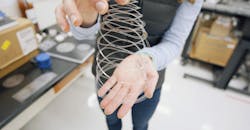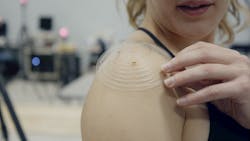Sensor Patch Monitors Shoulder for Better Injury Recovery
When Max Shtein, a professor of materials science and engineering at the University of Michigan crashed his bicycle and broke his collarbone, he found the physical therapy haphazard; the therapist had to use a simple protractor to crudely assess his shoulder’s range of motion. This seemingly antiquated method is prone to large errors and Shtein could not repeat the measurements at home.
That experience inspired him to design a shoulder patch/sensor that could more accurately record the movement of a shoulder, one of the most well-articulated joints in the body.
“Nobody’s really been able to track shoulder movement properly with anything wearable, and yet it’s key to so many activities in sports and daily life,” says Shtein.
He realized that a wearable sensor could have recorded the full scope of his motion and tracked his exercises, but it is expensive to build electronics onto curved structures. This sensor would need to be manufactured flat but still be able to follow the contour of a patient’s shoulder.
Erin Evke demonstrates how the cut patterns in the kirigami sensor open so that it follows the curve of her shoulder. This lets the sensor be manufactured flat, which is crucial to making the device affordable. (Credit: Levi Hutmacher, Michigan Engineering)
To solve that problem, he teamed up with Erin Evke, a doctoral student in materials science and engineering, and devised a device inspired by kirigami, the Japanese art of creating 3D structures from precisely cut sheets of paper. Evke laser-cut a thin sheet of plastic into a labyrinth of concentric ovals. The shape pulls apart almost like a Slinky, and the cuts open into a lacework that covers the shoulder.
“If you take a sheet of paper and try to wrap it around a sphere, it’s impossible to do so without folding or wrinkling the paper. This would significantly stress the sensors before measurements even began,” says Evke. “Our cut pattern avoids that problem.”
Because these structures transform from a flat sheet to a wrinkle-free, 3D shape, they can be manufactured with existing, cost-effective technologies. Shtein estimates that the cost of individual sensors could be below $10, assuming mass production. That’s much less than the cost of a single physical therapy appointment and could be an inexpensive way to improve patient outcomes.
As a proof-of-concept, the team equipped the kirigami patch with two strain gauges—one along the corner of the shoulder to capture the raising and lowering of the arm, and the other at the back of the shoulder to measure cross-body movements.
Shtein’s team then checked the data from the kirigami sensor against arm motions captured by a camera-based motion tracking device. It used reflective markers to track the angular positions of the arm and reconstruct them in a computer simulation. The two sets of data matched closely.
The team envisions that this kind of inexpensive sensor could be given to physical therapy patients, allowing them to log exercises and see progress through a smartphone app. This could help keep patients honest about doing physical therapy and also provide more detailed information to therapists about each patient’s progress.
Erin Evke demonstrates how the kirigami cut pattern opens into a lacey circle that could conform to a shoulder. (Credit: Levi Hutmacher, Michigan Engineering)
“Since doctors could tune the cut design to match the curvatures of all different parts of a body, they could also generate a lot of data to track your form—for instance, while weight lifting—as well as the amount of strain applied on your joints,” says Evke. “Coaches could alert users of improper form in real-time and therefore prevent injuries.”
Shtein pointed out that doctors don’t have good ways to measure joints and understand how to care for them. Recent work suggests that tears in the anterior cruciate ligament, a serious knee injury experienced by many athletes, occur as a result of cumulative stresses rather than a single excessive force. Similar issues occur with the shoulder joint. Inexpensive sensors could measure stresses so that athletes and trainers could recognize evolving problems and head off major injuries.



